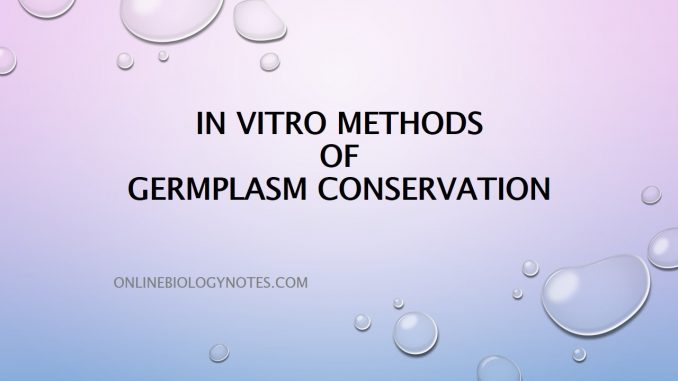
In vitro conservation of plant germplasm
- In vitro method is an advanced technology of ex situ conservation for the preservation of genetic materials.
- In vitro methods employing shoots, meristems and embryos are ideally suitable for the preservation of germplasm of vegetatively propagated plants.
- This approach can also preserve plants with recalcitrant seeds and genetically engineered materials along with orthodox plants.
- The conservation implies preservation of cells, calluses or tissues of selected plant species in sealed test tubes in in vitro method.
- This conservation depends on principle that plant cells are totipotent and plant materials can be kept alive for infinite period of time as in vitro cultures.
- Advantages:
- Requires less area for preservation of large quantities of materials.
- The germplasm are preserved in pathogen-free environment.
- Genetic materials are protected against the nature’s hazards.
- Large number of plants can be obtained from the germplasm stock whenever required.
- Since the germplasm is kept under aseptic conditions, it can be easily transported.
- Disadvantage:
- It requires constant electricity, skilled manpower and high technology.
Techniques for the in vitro conservation of germplasm:
- Cryopreservation (freeze-preservation)
- Cold storage
- Low-pressure and low-oxygen storage
1. Cryopreservation:
- Cryopreservation (Greek, krayos-frost) actually means preservation in the frozen state.
- Cryopreservation is based on the principle where the metabolism or division of plant cells and tissue cultures are completely halted by reducing temperatures with the involvement of cryoprotectants.
- This approach is highly applicable for the conservation of plant species in danger of extinction.
- Cryopreservation broadly refers to the storage of germplasm at very low temperatures:
- i. Over solid CO2 (at -79°C)
- ii. Low temperature deep freezers (at -80°C)
- iii. In vapour phase nitrogen (at -150°C)
- iv. In liquid N2 (at -196°C)
- Out of these, the most commonly used cryopreservation is use of liquid nitrogen.
- At the temperature of liquid nitrogen (-196°C), the cells remain in totally inactive state and thus can be preserved for long time.
- Cryopreservation has been applied for germplasm conservation of several plant species e.g. rice, wheat, peanut, cassava, sugarcane, strawberry, coconut.
- Various plants can be regenerated from cells, meristems and embryos stored in cryopreservation.
2. Cold Storage:
- Germplasm conservation at a low and non-freezing temperatures (1-9°C) is involved in this stage.
- In contrast to complete stoppage of cryopreservation, the growth of the plant material is slowed down in cold storage.
- Thus, cold storage is considered as a slow growth germplasm conservation method.
- This approach avoids the cryogenic injuries of plant material.
- This step is simple, economical and results germplasm with good survival rate.
- This approach stores many in vitro developed shoots/plants of fruit tree species for e.g. grape plants, strawberry plants.
- With the addition of a few drops of medium periodically (once in 2-3 months), virus- free strawberry plants could be conserved at 10°C for about 6 years.
3. Low-Pressure and Low-Oxygen Storage:
- Low-pressure storage (LPS) and low-oxygen storage (LOS) are other alternatives for the cryopreservation and cold storage which have been developed for germplasm conservation.
Low-Pressure Storage (LPS):
- The atmospheric pressure surrounding the plant material is decreased in low pressure storage.
- This yields in a partial reduction of the pressure exerted by the gases around the germplasm.
- The lowering of partial pressure decreases the in vitro growth of plants (of organized or unorganized tissues).
- Low-pressure storage systems are essential for both short and long-term storage of plant materials.
- The short-term storage is specifically useful to enhance the shelf life of many plant materials e.g. fruits, vegetables, cut flowers, plant cuttings.
- The storage of germplasm grown in cultures can be done for long term under low pressure.
- Besides germplasm preservation, LPS decreases the activity of pathogenic organisms and prevents spore germination in the plant culture systems.
Low-Oxygen Storage (LOS):
- In the low-oxygen storage, the oxygen concentration is decreased, but the atmospheric pressure (260 mm Hg) is maintained by the addition of inert gases (specifically nitrogen).
- There is reduction in plant tissue growth if the partial pressure of oxygen is below 50 mm Hg.
- It is because, with less availability of O2, the production of CO2 is low.
- As a result, the photosynthetic activity is decreased, thereby halting the plant tissue growth and dimension.
- Limitations:
- The long-term conservation of plant materials by low-oxygen storage may halt the plant growth after certain dimensions.
